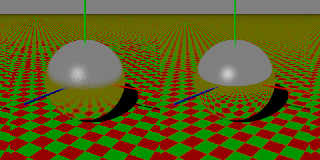|
 |
On 1/10/21 7:30 PM, Bald Eagle wrote:
> Cousin Ricky <ric### [at] yahoo com> wrote:
>> I tried blurred reflections using averaged micronormals of 9 built-in
>> patterns. 10 normals are averaged in each frame. I used a bump size of
>> 0.1 for all patterns, so the differences in blurriness between frames
>> are intrinsic to the patterns.
With what sort of anti-aliasing?
>
> Interesting results, given that in my source-code research on the pattern
> functions, spotted, bozo and bumps IIRC are all just f_noise3d, while dents is
> the result of that function cubed.
>
The bumps, dents and wrinkles patterns have unique normal block
implementations. Bumps being a little more expensive than bozo and
spotted makes sense to me.
Agate is the only one of the set having an internal turbulence component.
What is little curious to me are the photon times. Bumps about the same
as spotted and bozo? And there is crackle where the photon time is
significantly more expensive. Crackle has internally a crackle cache. Is
it not as effective when shooting photons?
...
>
> Really very nice experiment and beautiful renders. You are patient and
> meticulous as always. :)
>
Indeed!
Forgive me, but I'm going to use this thread as a reason to talk aloud
some about micro-normals / blurred reflection and some about the
non-biased rendering aspect Haj indirectly brought up with his mention
of Blender's Cycles.
I believe a part of more realistic / better looking renders is taking
more samples - kinda no matter the details of how you do it. Render
large and scale down and so on.
Attached is an image of 4 renders. In all, I start by forcing a lot of
rays -> "+a0.0 +am2 +r4." In the second and fourth column I try to add
micro-normals using povr's updated quilted, true normal, perturbation
pattern. Just: normal { quilted -0.175 scale 0.0005 }.
The left two columns demonstrate the strong pixel bias long built into
POV-Ray. AA doesn't ever jitter outside a pixel or in fact outside any
super-sampled sub-pixel - so the bias to a fixed grid of samples
strengthens as AA recursion depth increases. The jitter in v3.7/v3.8 is
itself not very random - no better than no jitter in most cases.
In povr you can use big jitter (values > 1.0). The jitter is made larger
as recursion depth increases because it is specified relative to the
smallest possible sub-sampled pixel. The controls "+a0.0 +am2 +r4
+j37.0" are used in the right two renders.
All the renders shoot the same number of rays. The constrained to pixel
bias in the left two (as in POV-Ray proper) makes those rays less
helpful to the end result.
The averaged normals method remains useful in situations where you don't
otherwise have moire' effects requiring more samples. The AA kicks in
locally in such cases for the blurred effect so it's likely more efficient.
Bill P. com> wrote:
>> I tried blurred reflections using averaged micronormals of 9 built-in
>> patterns. 10 normals are averaged in each frame. I used a bump size of
>> 0.1 for all patterns, so the differences in blurriness between frames
>> are intrinsic to the patterns.
With what sort of anti-aliasing?
>
> Interesting results, given that in my source-code research on the pattern
> functions, spotted, bozo and bumps IIRC are all just f_noise3d, while dents is
> the result of that function cubed.
>
The bumps, dents and wrinkles patterns have unique normal block
implementations. Bumps being a little more expensive than bozo and
spotted makes sense to me.
Agate is the only one of the set having an internal turbulence component.
What is little curious to me are the photon times. Bumps about the same
as spotted and bozo? And there is crackle where the photon time is
significantly more expensive. Crackle has internally a crackle cache. Is
it not as effective when shooting photons?
...
>
> Really very nice experiment and beautiful renders. You are patient and
> meticulous as always. :)
>
Indeed!
Forgive me, but I'm going to use this thread as a reason to talk aloud
some about micro-normals / blurred reflection and some about the
non-biased rendering aspect Haj indirectly brought up with his mention
of Blender's Cycles.
I believe a part of more realistic / better looking renders is taking
more samples - kinda no matter the details of how you do it. Render
large and scale down and so on.
Attached is an image of 4 renders. In all, I start by forcing a lot of
rays -> "+a0.0 +am2 +r4." In the second and fourth column I try to add
micro-normals using povr's updated quilted, true normal, perturbation
pattern. Just: normal { quilted -0.175 scale 0.0005 }.
The left two columns demonstrate the strong pixel bias long built into
POV-Ray. AA doesn't ever jitter outside a pixel or in fact outside any
super-sampled sub-pixel - so the bias to a fixed grid of samples
strengthens as AA recursion depth increases. The jitter in v3.7/v3.8 is
itself not very random - no better than no jitter in most cases.
In povr you can use big jitter (values > 1.0). The jitter is made larger
as recursion depth increases because it is specified relative to the
smallest possible sub-sampled pixel. The controls "+a0.0 +am2 +r4
+j37.0" are used in the right two renders.
All the renders shoot the same number of rays. The constrained to pixel
bias in the left two (as in POV-Ray proper) makes those rays less
helpful to the end result.
The averaged normals method remains useful in situations where you don't
otherwise have moire' effects requiring more samples. The AA kicks in
locally in such cases for the blurred effect so it's likely more efficient.
Bill P.
Post a reply to this message
Attachments:
Download 'microblur_aajitter.jpg' (263 KB)
Preview of image 'microblur_aajitter.jpg'

|
 |




![]()